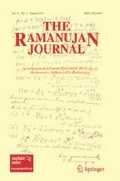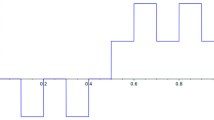Abstract
Algebraic hypergeometric functions can be compactly expressed as radical functions on pull-back curves where the monodromy group is simpler, say, a finite cyclic group. These so-called Darboux evaluations have already been considered for algebraic \({}_{2}\text{ F }_{1}\)-functions. This article presents Darboux evaluations for the classical case of \({}_{3}\text{ F }_{2}\)-functions with the projective monodromy group \(\hbox {PSL}(2,\mathbb {F}_7)\). The pullback curves are of genus 0 (in the simplest case) or of genus 1. As an application of the genus 0 evaluations, appealing modular evaluations of the same \({}_{3}\text{ F }_{2}\)-functions are derived.
Similar content being viewed by others
Notes
Correspondingly, \((\#\Lambda )/7=24\) is the smallest degree of Darboux coverings that reduce the projective monodromy \(\Lambda \) to a cyclic group. But smaller degree Darboux coverings exist that give pull-back transformations to reducible monodromy representations. In [35], Darboux coverings of degree 21 of the considered Fuchsian equations are given. They transform the projective monodromy \(\Lambda \) to a dihedral group of order 8.
The branching pattern (or the passport [17]) of a Belyi map gives the branching orders of all points in the 3 fibers \(\varphi =0\), \(\varphi =1\), \(\varphi =\infty \). Particularly, \(7^31^3\) prescribes 3 seven-fold points and 3 non-branching points in one fiber, while \(3^8\) prescribes all points to be threefold in other fiber, etc.
There are these typos in [7]: Formula (4.19) is actually for \(j_7^{-1}\), not for \(j_7\). In formula (4.23), a minus sign is missing before \(\mathsf{y}^2\mathsf{z}/\mathsf{x}^3\). Formula (1.18) should be adjusted by \(40\Phi _4^2\Phi _6 (3\Phi _{14}^2+1008\Phi _4\Phi _6^4+56\Phi _4^2\Phi _6\Phi _{14}-832\Phi _4^4\Phi _6^2-256\Phi _4^7)\). In formula (4.35), the factor \(5\phi ^2-15\phi -7\) should be \(5\phi ^2-14\phi -7\).
References
Berndt, B.C., Chan, H.H., Huang, S.S., Kang, S.-Y., Sohn, J., Son, S.H.: The Rogers–Ramanujan continued fraction. J. Comput. Appl. Math. 105, 9–24 (1999)
Beukers, F., Heckman, G.: Monodromy for the hypergeometric function \(_{n}F_{n-1}\). Invent. Math. 95, 325–354 (1989)
Brox, D.: The Riemann hypothesis and emergent phase space. J. Mod. Phys. 8, 459–482 (2017)
Cummins, C.J., Pauli, S.: Congruence subgroups of \(\text{ PSL }(2,\mathbb{Z})\) of genus less than or equal to \(24\). Exp. Math. 12, 243–255 (2003)
Diamond, F., Shurman, J.: A First Course in Modular Forms. Graduate Texts in Mathematics, vol. 228. Springer, New York (2005)
Duke, W.: Continued fractions and modular functions. Bull. Am. Math. Soc. 42, 137–162 (2005)
Elkies, N.: The Klein quartic in number theory. pp. 51–101 in [18]
Franc, C., Mason, G.: Hypergeometric series, modular linear differential equations and vector-valued modular forms. Ramanujan J. 41, 233–267 (2016)
Halphen, G.-H.: Sur une équation différentielle linéaire du troisiéme ordre. Math. Annalen 24, 461–464 (1884)
Hoshino, K.: The Belyi functions and dessin d’enfant corresponding to the non-normal inclusions of triangle groups. Math. J. Okayama Univ. 52, 45–60 (2010)
Hurwitz, A.: Ueber einige besondere homogene lineare Differentialgleichungen. Math. Annalen 26, 117–126 (1886)
Hurwitz, A.: Über algebraische Gebilde mit eindeutigen Transformationen in sich. Math. Annalen 41, 403–442 (1893)
Kaneko, M.: On modular forms of weight \((6n+1)/5\) satisfying a certain differential equation. In: Zhang, W., Tanigawa, Y. (eds.) Number Theory, Developments in Mathematics, vol. 15, pp. 97–102. Springer, Boston (2006)
Kato, M.: Algebraic transformations of \({}_{3}\text{ F }_{2}\). Kyushu J. Math. 51, 221–243 (2008)
Kato, M.: Schwarz images of algebraic \({}_{3}\text{ F }_{2}\). Kyushu J. Math. 65, 299–333 (2011)
Klein, F.: Ueber die Transformation siebenter Ordnung der elliptischen Functionen. Math. Annalen 14, 428–471 (1879). An English translation is [18, pg. 287–331]
Lando, S.K., Zvonkin, A.K.: Graphs on Surfaces and their Applications, Vol 141 of Encyclopedia of Mathematical Sciences. Springer, New York (2004)
Levy, S. (ed.): The Eightfold Way: The Beauty of Klein’s Quartic Curve. MSRI Publications 35, Cambridge University Press, Cambridge (1998)
Llibre, J., Zhang, X.: Darboux theory of integrability for polynomial vector fields in \(\mathbb{R}^n\) taking into account the multiplicity at infinity. Bull. Sci. Math. 133, 765–778 (2009)
Macbeath, A.M.: Hurwitz groups and surfaces. pg. 103–113 in [18]
Maier, R.S.: Algebraic hypergeometric transformations of modular origin. Trans. Am. Math. Soc. 359, 3859–3885 (2007)
Rainville, E.D.: The contiguous function relations for \(_{p}\text{ F }_{q}\) with applications to Bateman’s \(J_n^{u, v}\) and Rice’s \(H_n(\zeta, p, v)\). Bull. Am. Math. Soc. 51, 714–723 (1945)
Rogers, L.J., Ramanujan, S.: Proof of certain identities in combinatory analysis. Camb. Phil. Soc. Proc. 19, 211–216 (1919)
Schwarz, H.A.: Über diejenigen Fälle in welchen die Gaussische hypergeometrische Reihe einer algebraische Funktion ihres vierten Elementes darstellt. Crelle J. 75, 292–335 (1873)
Selberg, A.: Über einige arithmetische Identitäten. Avh. Norske Vidensk.- Akad. Oslo I 8, 23S (1936)
Shephard, G.C., Todd, J.A.: Finite unitary reflection groups. Can. J. Math. 6, 274–304 (1954)
Silverman, J.H.: The Arithmetic of Elliptic Curves. Springer, Dordrecht (2009)
Stack Exchange website, Hypergeometric formulas for the Rogers–Ramanujan identities?, (2014). https://math.stackexchange.com/questions/171589
Subbarao, M.V., Vidyasagar, M.: On Watson’s quintuple product identity. Proc. Am. Math. Soc. 26, 23–27 (1970)
van der Put, M., Ulmer, F.: Differential equations and finite groups. J. Algebr. 226, 920–966 (2000)
Vidunas, R.: Transformations of some Gauss hypergeometric functions. J. Comput. Appl. Math. 178, 473–487 (2005)
Vidunas, R.: Algebraic transformations of Gauss hypergeometric functions. Funkcialaj Ekvacioj 52, 139–180 (2009)
Vidunas, R.: Dihedral Gauss hypergeometric functions. Kyushu J. Math. 65, 141–167 (2011)
Vidunas, R.: Darboux evaluations of algebraic Gauss hypergeometric functions. Kyushu J. Math. 67, 249–280 (2013)
Vidunas, R.: Dihedral evaluations of hypergeometric functions with the Kleinian projective monodromy. Integr. Transform. Spec. Funct. 30, 316–333 (2019)
Weil, J.A.: Constant et polynómes de Darboux en algébre différentielle: applications aux systémes différentiels linéaires. Ph.D. thesis, École Polytechnique, (1995)
Zagier, D.: Elliptic modular forms and their applications. pp. 1–103 in Bruinier, J.H., van der Geer, G., Harder, G., Zagier, D., The 1-2-3 of Modular Forms, UK: Springer (2008)
Author information
Authors and Affiliations
Corresponding author
Additional information
Publisher's Note
Springer Nature remains neutral with regard to jurisdictional claims in published maps and institutional affiliations.
Rights and permissions
About this article
Cite this article
Vidunas, R. Darboux evaluations for hypergeometric functions with the projective monodromy \(\hbox {PSL}(2,\mathbb {F}_7)\). Ramanujan J 53, 85–121 (2020). https://doi.org/10.1007/s11139-019-00229-x
Received:
Accepted:
Published:
Issue Date:
DOI: https://doi.org/10.1007/s11139-019-00229-x




